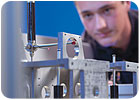
Proper maintenance of coordinate-measuring machines (CMMs) basically consists of two key services that are often confused: Preventive maintenance (PM) and machine calibration. Maintenance includes machine inspection, replacement of worn or damaged components, hardware (mechanical/electrical) adjustments, and thorough cleaning to ensure the machine is in a reliable condition. Calibration service generally consists of verifying how the machine measures and making necessary accuracy adjustments to achieve optimal data results. Many manufacturers believe that a calibration is sufficient to keep the machine running and in peak condition. In reality, calibrating a machine without having performed preventive maintenance leaves the manufacturer open to problematic and possibly costly repair.To avoid unnecessary repair, emphasis on preventive maintenance should be considered in addition to the calibration during your next scheduled service.
Before scheduling a service call, manufacturers should define a few machine specifics such as:

What are the quality requirements? Does the machine need an ISO17025 calibration?
ISO 017025 is a calibration system standard and a requirement for manufacturers producing parts for an automotive manufacturer. It is a documented quality process from start to finish that provides information on how the machine is performing before it is serviced. Both the before and after calibration data include linear measurement uncertainty and scanning performance uncertainty, which are only produced as a result of this particular process.

What is the operational uptime? How many hours is the machine used per day?
Many manufacturers run more than one shift.Calculated over one year, one shift generally adds up to 2,000 hours of machine operation if the machine is used throughout the course of that shift. If the machine is operated on a two or three shift period, the intervals of the machine maintenance and calibration services should be increased to ensure best performance. The manufacturer recommended maintenance intervals serve here as a guideline and should be followed.Utilizing a “Full Service” provider, which is in most cases the original manufacturer and understanding your operational needs are key to ensuring your machine is in optimum condition. The full service provider can assist you in developing and implementing a machine maintenance program tailored to your operational requirements. While on-site, they are trained to identify performance issues and correct them accordingly. This prevents future machine failure and eliminates expenses associated with a follow-up repair service. In addition, they are capable of adjusting the machine mechanics, controller or accuracy. This generally requires manufacturer proprietary software.
The benefits of maintaining your inspection system not only include increased machine uptime, but also extended lifetime of components, reduced maintenance costs and optimal inspection results. After a complete maintenance service has been performed, the machine is going to be in a reliable condition for basically one year or 2,000 hours of operation. Planned maintenance is better than to encounter expensive and unnecessary downtime as a result of a not properly adjusted machine.
A few CMM manufacturers even offer remote support services that can make an on-site service call unnecessary or reduce its costs. During the online session, technicians can determine the cause and adjust the machine remotely or decide which parts to bring on a service call. For remote service, only a network connection is needed to allow opt-in desktop sharing and therefore monitoring of CMM computer and machine. Remote service puts your machine back into action quickly and reduces downtime even further.

By Jeff Parcher, Service Manager - Carl Zeiss IMT Corporation